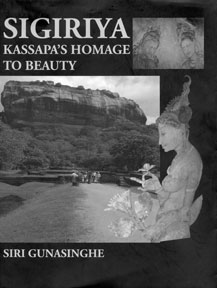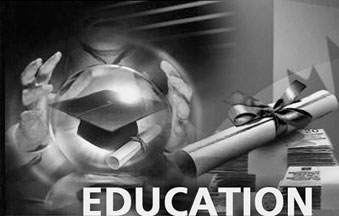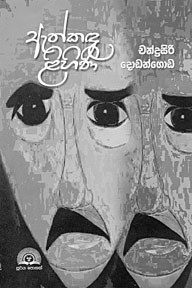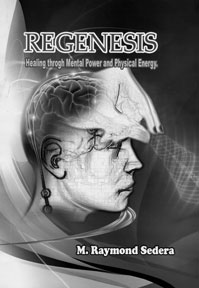|

Debunking many a theory on Sigiriya
Reviewed by Padma Eririsinghe
“Give me a bard said” Lanka
“He shall hymn thee of hoary Sri Pada
The peak that is lone and tall
He shall sing thee of sheer Sigiriya
Of Minneriya’s wandering kine”
(W. S. Senior)
The most recent bard to sing of sheer Sigiriya comes from the highest
portals of our world of academia that inevitably makes the book far more
than an emotive hymn.
More than a hymn or while being a hymn to what has been designated as
the most exquisite architectural edifice in the island so far, “Sigiriya
- Kassapa’s homage to beauty” ends up as a very serious research work on
“What Sigiriya was?” And that entails not only the identity of the
structure on the massive rock but the character of the builder and the
identity of the famous damsels trekking a voyage since the 5th C.
 These issues over the years has become intriguing ones for scholars
and writers and many varied ideas propounded. The initial catalyst for
the emergence of the work seems to have resulted from the author’s
disagreement with another writer who propounded the idea that “Sigiriya
was but a shadow of Ajantha”. After dismantling that theory he goes on
to debunk many other theories on the subject, some advocated by academic
luminaries as Dr. S. Paranavithana and Dr. Coomaraswamy and Raja De
Silva. It is a pity that no reference is made to very scholarly
observations on Sigiri paintings (boldly criticizing some of
Paranavithana’s ideas) by K. Jayatileka, the “academic” who never had a
University education. These issues over the years has become intriguing ones for scholars
and writers and many varied ideas propounded. The initial catalyst for
the emergence of the work seems to have resulted from the author’s
disagreement with another writer who propounded the idea that “Sigiriya
was but a shadow of Ajantha”. After dismantling that theory he goes on
to debunk many other theories on the subject, some advocated by academic
luminaries as Dr. S. Paranavithana and Dr. Coomaraswamy and Raja De
Silva. It is a pity that no reference is made to very scholarly
observations on Sigiri paintings (boldly criticizing some of
Paranavithana’s ideas) by K. Jayatileka, the “academic” who never had a
University education.
Actually a good part of the book deals with a negative aspect i.e.
What Sigiriya is not. This could be the book’s strength more than its
weakness and stems from the fact that Sigiriya over centuries has
garnered immense popularity as an architectural riddle... No. Sigiriya
is not a military fortress. Yet again, it is not a replica of Alakamanda
where reigned the mythical Kuvera. Neither is it a Mahayana monastery.
But it is a famed don waxing on these ideas and necessarily that entails
giving very plausible and meticulously researched reasons for these
arguments.
It is again not a hideout of a king scared of his younger brother got
built. And here the reasons given are very cogent. Will a frightened
monarch go on to build an extensive assemblage of buildings, parks,
ponds and pathways covering a massive area enclosed by moats and
ramparts? Here is the main axis of the don’s arguments on which the
whole book rotates,” Sigiriya was a pleasant environment created
expressly for Kasyapa’s delectation Kasyapa’s strong aesthetic
disposition is evident all over”.
Further, in Sigiriya there is only art and no sign of war’. To
buttress this argument the author wades into a detailed description of
the beauty of Sigiriya dropping the axe on the Mahavamsa as he goes on
for its biassed treatment of Kasyapa especially in transforming him into
a murderer accused of patricide. He, implies the don, was too
aesthetically sensitive for a heinous crime.
The story of Kassapa the patricide seems to be a popular tale of a
palace coup that had developed into a murder myth over a period of 8Cs
when the chronicler finally recorded it in the Mahawansam. Actually it
is the Chulavamsa that records it and the author’s use of the title MV
for CV (explained later only in an obscure footnote) confuses the
non-discerning reader.
So we see tables turned on many hitherto beliefs including that on
that of the Sigiriya frescoes popularly known as the Sigiriya beauties.
These comprise the celebrated wall paintings for which Sigiriya became
famous all over the world. Here too he debunks theories held so far. No.
They are not heavenly beings.
Nor nymphs. Nor anthromorphic representations of clouds and
lightning. Nor are they Taras. Nor are they shadows of Ajantha. Then
what are they? What are these murals that are the best preserved and the
oldest surviving example of the art of the painter in ancient Lanka
especially as examples of a rare secular art when arts were employed
largely in the service of religion?
The enigma of these paintings the author solves in his own way after
a tantalising account of how these women were discovered basking on the
rock wall, almost 15 centuries after they were painted.
From extra terrestrial figures spawned in many a learned person’s
mind the author plummets these damsels into solid ground. Here is the
author himself. “Their informal distribution on the uneven rock surface
suggested that the painters were guided mainly by a need to create a
beautiful space rather than a sacred or heavenly territory.”
No. They do not have a narrative nor symbolic function. “Instead of
telling a story, the only narrative function they perform is to be
present and play with flowers”.
Anyway one cannot help but remark that Dr. Siri Gunasinghe has
unlocked a world of secrets that had been hitherto fantasized and
brought the reader close to earth.
Whether the reader accepts or not his well-researched arguments is
another matter. The author divides his time between Canada and Sri Lanka
now, yet not forgetting such riddle areas that cry to be solved in his
native land. At Peradeniya campus in the late “50s he was a distant
figure to me, looming high above.
Yet as he handed me this valuable work for review in the opening
decades of the 21st Century some 52 years later I could not help
thinking how many years and years we have journeyed along the track of
Time.
To the readers I have this message, “Happy reading of a remarkable
work spawned out of the art of writing.” The book is profusely
illustrated and transpires the dedication Vijitha Yapa Publishers allot
to their productions. It is a must for any library.
A gentle odyssey
Reviewed by Tissa Devendra
“From Hikkaduwa to the Carolinas” - Lakshman Abeyagunawardena
‘Odyssey’ is, perhaps, not quite the perfect word to describe the
travels of Dr. Lakshman Abeyagunawardena the peace-loving physician far
removed from the warlike Odysseus. But, like the latter who came back,
after his adventures, to his homeland in Ithaca - Lakshman too has
returned to his own homeland in Sri Lanka to reflect in tranquillity and
write this pleasant book he subtitles “Memoirs of a Reluctant
Expatriate.”
This autobiography is, in many ways, a distant mirror to a country
and a way of life now gone beyond recall. Born in the early 1940s, at
the tail-end of the Colonial era, to the family of a middle rank
government servant (as we were called), Lakshman had a quiet and
peaceful progress through school and University where he graduated in
Medicine in 1967. He is blessed with a fine memory as demonstrated in
his recollections of the names and doings of his schoolmates and
teachers of Ananda College he is proud to acknowledge. I particularly
enjoyed his description of boyhood in the government “colony” of Manning
Town with its (for this social class) typical and interesting mix of
Sinhalese, Tamil and Burgher families - hardly ever seen today, alas. A
brief extract will convey the camaraderie of old Manning Town:
“The children’s playground was behind the clubhouse (the Government
Officers’ Club). It was there the children assembled in the evenings. As
with most clubs, there were the annual tournaments and club nights. When
the club had a Fancy Dress Parade on one such occasion in 1953, as a
twelve-year-old, I was runner-up dressed in the costume of an Afghan
moneylender.” These fierce chaps who hung around offices on payday to
extract their “pound of flesh” from indigent clerks have long vanished
into oblivion as have the gentler pastimes of yesterday’s spacious
Manning Town, now usurped by crowded tower flats.
A pleasant sojourn as a science teacher in The Central College at
scenic Talatu Oya was sandwiched between school and University.
Typical of the writer is his diversion to praise the impact of
Kannangara’s Central schools in distant rural areas. One can glimpse the
impact this handsome young teacher had on his students from his account
of his farewell:
“What was most touching was the way some of the senior female
students dressed in ‘lama saris’... were wiping away their tears with
crumpled handkerchiefs (at the) impending departure of their ‘Podi
Sir’.”
Lakshman’s gift of total recall is seen in his account of his years
at Medical College where he recalls his batch-mates with affection and
his ‘gurus’ with respect - and goes on to sketch their subsequent
achievements.
His career as a government doctor began with an interesting interlude
in what was called ‘the VD Clinic.’ This was followed by a spell at
Kalubowila Hospital where he gained hands-on experience of the suffering
and drama of the patients who flowed through its corridors and wards.
His sympathetic interest in people and his country led Lakshman to
specialise in the field of Public Health instead of the lucrative option
of Clinical Medicine. Thus it was that we met in Matara where he was
Medical Officer of Health. It was also his wife’s home and the place
where the young Abeyagunawardenas became parents. While in Matara
Lakshman weathered the JVP Insurgency of 1971 of which he gives an all
too brief account.His field experience and his natural sympathy for his
countrymen in the remote regions of our homeland led him to specialize
in the new (for Sri Lanka) field of Health Education. He describes the
pioneer years of the Health Education Bureau as its golden years and
showers praise on the specialists and health workers who worked
tirelessly and inspired countless volunteers and schoolchildren to
spread the ‘good word.’
It was inevitable that an officer of this dedication and integrity
would be recruited into the UN system after his postgraduate studies in
the US. This was when his Odyssey really took off. A fair sprinkling of
adventures marks this phase with a near fatal plane crash its highlight,
and the amusing ‘banquet’ in West Timor where the phrase ‘dig bite’
acquired a new meaning.
Finally on to life in the US - the Carolinas to be more specific,
where he had a fulfilling life in academia and much interaction with his
former colleagues and friends who had joined the ‘brain drain’ earlier.
But not Lakshman who has, like Odysseus, come back to his own Ithaca to
entertain us with his memoirs.
Whither the Colleges of Education?
by Chandra Karunadasa
“Thirty-three students from the Uva - Wellassa College of Education
were remanded for breaking open the college office in an attempt to
steal the question papers of the final examination “was the head-line in
several newspapers this week. Alas! They are the future members of a
noble profession, expected to guide the younger generation to be dutiful
citizens of our country.
 Teachers are expected to be of excellent character from the days of
yore. The Buddha was Saththa, the greatest, and the noblest teacher who
trod on earth. He was the noblest of the noble in demeanour, personality
and conduct. His methods of teaching were exemplary and educationists
and psychologists Buddhists and non-Buddhists have compiled volumes on
His noble methods of teaching. Teachers not only in this country where
the majority of the people are Buddhists, but also the world over are
expected to be of exemplary character. They are the Guru Devi -gods and
goddesses among the humans. Even an ordinary person without a formal
education - expects the teachers to be of exemplary character. In a
teaching career of twenty-five to thirty years or more, thousands of
young children are influenced by a teacher. Hence the colloquialism
“what the teacher does standing, the pupil does running”. Teachers are expected to be of excellent character from the days of
yore. The Buddha was Saththa, the greatest, and the noblest teacher who
trod on earth. He was the noblest of the noble in demeanour, personality
and conduct. His methods of teaching were exemplary and educationists
and psychologists Buddhists and non-Buddhists have compiled volumes on
His noble methods of teaching. Teachers not only in this country where
the majority of the people are Buddhists, but also the world over are
expected to be of exemplary character. They are the Guru Devi -gods and
goddesses among the humans. Even an ordinary person without a formal
education - expects the teachers to be of exemplary character. In a
teaching career of twenty-five to thirty years or more, thousands of
young children are influenced by a teacher. Hence the colloquialism
“what the teacher does standing, the pupil does running”.
The Colleges of Education concept was borrowed from the United
Kingdom. The idea was to train teachers with knowledge, skills and
correct attitudes before he or she takes to the task of teaching. An
untrained teacher with no knowledge of Educational Psychology,
Principles of Education and guidance of experienced teachers, can cause
much harm to the tender minds of the students. For this reason in
developed countries untrained teachers are not given the responsibility
of guiding young children in the classroom.The National Colleges of
Education were set up in Sri Lanka in 1985. They were to train good
teachers equipped with knowledge, skills and the correct attitudes so
that the schools would have qualified teachers to provide a better
service to the students. The Colleges were to train teachers in
different subjects - namely, Pasdunrata National College for English,
Siyane for Science and Mathematics, Hapitigoma for Primary Education,
Nilwala for Home Science and Primary Education, Mahaweli for Primary
Education and Bandarawela for Physical education.
The Sri Pada College of education was for Tamil medium students. Over
the years the number of colleges of education has increased and today
the country could be proud of seventeen colleges of education.
Prior to the introduction of the new system of teacher training,
there were different systems of training. Apart from the university,
open university and NIE courses there were systems such as Distance
Training DELIC, PRINSETT and Postal courses of teacher-training to clear
the backlog of untrained teachers. Having conducted a number of
teacher-training courses the writer can definitely say that the college
of Education course which is fully residential and the trainee being
just out of school, is the best.
The admission criteria to the Colleges of Education was to select
those students who miss the entry to the university by a few marks. For
the Pasdunrata College there was an entrance test and viva-voce to
assess the students’ mastery of English. Since the students remain
unmarried they could devote their full time on education.
The course is fully-residential and the program for the day starts
with physical training, followed by the academic exercise. Until 3.30
p.m. the co-curricular activities of two hours duration until 6 p.m. too
are included in the day’s work. This scheme is much better than the
teacher-training programs of yesteryear where elderly and those married
with all sorts of family encumbrances were selected for training.
Almost all teachers who passed out of the Pasdunrata College of
Education became professionally qualified teachers. A large number
followed university courses while in service. It is heartening that some
have entered administrative and foreign services as well.
Many philosophers of education have enumerated the different roles
that a teacher has to play.
An eminent English educationist, O. A. Oeser has stressed the value
of Ethical Preceptor, Moralist and counsellor in his list. If they
would-be teachers are in the make of vandals, thieves and criminals the
fate of the younger generation in the country would definitely be bleak,
unfortunate and disastrous.
The writer is a former senior lecturer in Education and Educational
Psychology at the Pasdunrate National English College of Education.
New on the shelf
 Ethkanda Lihini Ethkanda Lihini
Chandrasiri Dodangoda’s latest Sinhala novel entitled “Ethkanda
Lihini” was launched by Sooriya Publishers in Colombo recently.
The story is about a youth who had come to Colombo from an interior
village in the South. By dint of hard work and perseverance he overcomes
poverty and becomes rich. The narrative, written in readable prose,
provides an insight into human life.
 Ama Dam Rasa Vehena Vistharartha Dhamma Padaya 7 saha 8 Ama Dam Rasa Vehena Vistharartha Dhamma Padaya 7 saha 8
Ama Dam Rasa Vehena Vistharartha Dhamma Padaya 7 saha 8 Ven.
Kiribathgoda Gnanananda Thera’s “Ama Dam Rasa Vehena Vistharartha Dhamma
Padaya 7 saha 8’ will be launched at the ACBC auditorium, Bauddhaloka
Mawatha, Colombo 7 on March 20 at 10.00 a.m.
The book launch will be followed by a meditation program.The two
books are published by Dayawansa Jayakody publishers.
 Regenesis Regenesis
Healing through mental power and physical energy
In this fascinating book the author M. Raymond Sedera explains how
“Regenesis” can be applied to heal both mental and physical problems.
According to him, it is a healing method through non-biological, non -
pharmaceutical ways. It is a process of mobilising and directing the
flow of cellular energy to stimulate, facilitate and accelerate the
natural healing of the human body. The book comes with relevant
illustrations.
The book is an author publication. It is available at “Wasana’
Kumbalagamuwa, Walapone.
|

